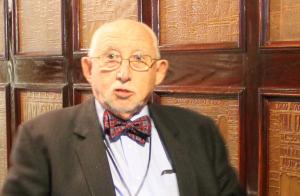Uncle Sam didn’t frack this one up.
Llewellyn King is Editor-at-Large for Public Utilities Fortnightly. He is the creator, executive producer and host of PBS’ “White House Chronicle,” a weekly news and public affairs program. King also writes a weekly column for the Hearst-New York Times Syndicate and for The Huffington Post. University Press of America collected his columns in “Washington and The World 2001-2005.” Over the years, King’s insightful reporting and analysis of energy has led to frequent guest spots on TV news shows, including NBC’s “Meet the Press” and PBS’s “The NewsHour with Jim Lehrer” and CNN.
It was the best of outcomes, it was the worst of outcomes.

The nation is awash in natural gas and oil. This did not just happen: It is the result of a long and fruitful collaboration between the government and private industry to develop advanced hydraulic fracturing. But one corporation and one man stand out: Mitchell Energy and its late visionary founder, George Phydias Mitchell.
Whenever I point this out I get a flood of mail, often abusive, claiming that modern fracking was a natural development of the traditional stimulation techniques used in the oil patch for many decades.
I love the story of fracking because it proves a lot of truths about how things get done.
First, the private sector needed to realize there were better ways of doing things, and that scientific resources in seismic and mapping would be essential. They also needed a better drill bit.
Enter Sandia National Laboratory. Government support for advanced drilling and extraction began in 1976 and continued through the 1980s and 1990s. Commercial exploitation began in the 1990s and exploded a decade later.
Previous government ideas about fracking were a little crazy and featured huge underground explosions using nuclear devices. Yes, just a little bomb was what was proposed. There were at least two government programs aimed at nuclear stimulation of natural gas in the 1950s and 1960s: One was called Wagon Wheel and the other, Gasbuggy.
Back in those days, nuclear was popular and people wanted it to have civilian uses of all kinds, possibly as an expiation for the bomb. Anyway nuclear gas stimulation ran into an immutable problem: the gas thus produced was radioactive. Not the kind of blue flame you want on your stovetop.
The nuclear enthusiasts, led by the congressional Joint Committee on Atomic Energy and the Atomic Energy Commission withdrew. Still, many were convinced that there would be a fix if the programs would just be allowed to continue. These programs, well, bombed. There were contractors, but no private partners.
Another tale of the government going it alone in energy had a dismal end. It was a program at Los Alamos National Laboratory to produce geothermal steam in a new way. The idea was scientifically sound. Los Alamos sits on an extinct volcano and deep in the earth there are what are known, rather unscientifically, as "hot rocks." The plan was to drill into these heated formations, pour in some water and, wham, there would be steam aplenty to drive turbines on the surface.
This program was the brainchild of Los Alamos, and I crawled over the site in the early days. Enthusiasm was abundant. It seemed to be an elegant addition to the geothermal resource base. However, there was too much government, in the form of the national lab, and not enough input from commercial geothermal operators.
After 17 years, the government funding was threatened, and I was invited to what turned out to be the burial for the project.
Finally, the government people met their commercial opposites and it didn't go well. The scientists knew, down to the smallest microbe, life down the well. They had oodles of data but it was the wrong data. In commercial geothermal, the cardinal question is the projected life of the reservoir. Sadly, Los Alamos had not kept records from which that could be calculated. The scientists had not thought of that necessity.
Then there were questions about what to do with the brine that would be a pollution problem when discharged from the turbine on the surface of the fragile high desert. There will be no brine problem, said Los Alamos. "We'll not bring the waste water to the surface. We'll use a heat exchanger, and the brine will dissipate down the well." The commercial operators said, "That won't work. Your temperatures are not hot enough to use a heat exchanger. You'll have to bring the steam to the surface and deal with it there after it comes out of the turbine. We've tried heat exchangers down geothermal wells and the heat degradation is too great. No deal."
This is a tale of huge success and dismal failure, and it has a moral: Public-private partnerships can work. The government, on its own, gets off track and screws up with our money. But private industry needs the government to shoulder the risk and provide its huge resources of capital and science to further the public interest.



